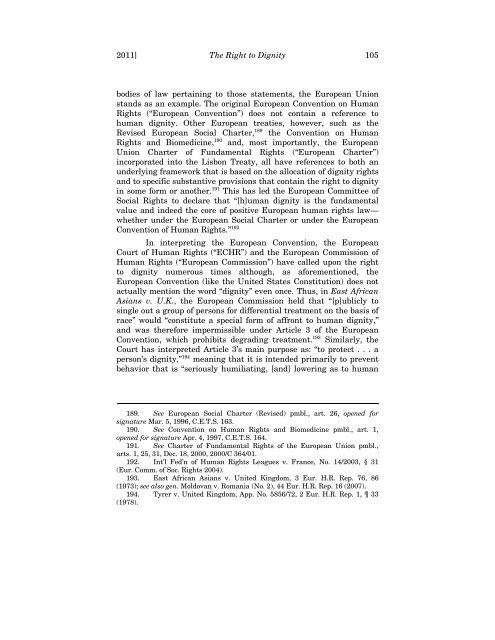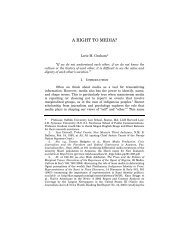The Right to Dignity Rex D. Glensy - Columbia Law School
The Right to Dignity Rex D. Glensy - Columbia Law School
The Right to Dignity Rex D. Glensy - Columbia Law School
Create successful ePaper yourself
Turn your PDF publications into a flip-book with our unique Google optimized e-Paper software.
2011] <strong>The</strong> <strong>Right</strong> <strong>to</strong> <strong>Dignity</strong> 105<br />
bodies of law pertaining <strong>to</strong> those statements, the European Union<br />
stands as an example. <strong>The</strong> original European Convention on Human<br />
<strong>Right</strong>s (“European Convention”) does not contain a reference <strong>to</strong><br />
human dignity. Other European treaties, however, such as the<br />
Revised European Social Charter, 189 the Convention on Human<br />
<strong>Right</strong>s and Biomedicine, 190 and, most importantly, the European<br />
Union Charter of Fundamental <strong>Right</strong>s (“European Charter”)<br />
incorporated in<strong>to</strong> the Lisbon Treaty, all have references <strong>to</strong> both an<br />
underlying framework that is based on the allocation of dignity rights<br />
and <strong>to</strong> specific substantive provisions that contain the right <strong>to</strong> dignity<br />
in some form or another. 191 This has led the European Committee of<br />
Social <strong>Right</strong>s <strong>to</strong> declare that “[h]uman dignity is the fundamental<br />
value and indeed the core of positive European human rights law—<br />
whether under the European Social Charter or under the European<br />
Convention of Human <strong>Right</strong>s.” 192<br />
In interpreting the European Convention, the European<br />
Court of Human <strong>Right</strong>s (“ECHR”) and the European Commission of<br />
Human <strong>Right</strong>s (“European Commission”) have called upon the right<br />
<strong>to</strong> dignity numerous times although, as aforementioned, the<br />
European Convention (like the United States Constitution) does not<br />
actually mention the word “dignity” even once. Thus, in East African<br />
Asians v. U.K., the European Commission held that “[p]ublicly <strong>to</strong><br />
single out a group of persons for differential treatment on the basis of<br />
race” would “constitute a special form of affront <strong>to</strong> human dignity,”<br />
and was therefore impermissible under Article 3 of the European<br />
Convention, which prohibits degrading treatment. 193 Similarly, the<br />
Court has interpreted Article 3’s main purpose as: “<strong>to</strong> protect . . . a<br />
person’s dignity,” 194 meaning that it is intended primarily <strong>to</strong> prevent<br />
behavior that is “seriously humiliating, [and] lowering as <strong>to</strong> human<br />
189. See European Social Charter (Revised) pmbl., art. 26, opened for<br />
signature Mar. 5, 1996, C.E.T.S. 163.<br />
190. See Convention on Human <strong>Right</strong>s and Biomedicine pmbl., art. 1,<br />
opened for signature Apr. 4, 1997, C.E.T.S. 164.<br />
191. See Charter of Fundamental <strong>Right</strong>s of the European Union pmbl.,<br />
arts. 1, 25, 31, Dec. 18, 2000, 2000/C 364/01.<br />
192. Int’l Fed’n of Human <strong>Right</strong>s Leagues v. France, No. 14/2003, § 31<br />
(Eur. Comm. of Soc. <strong>Right</strong>s 2004).<br />
193. East African Asians v. United Kingdom, 3 Eur. H.R. Rep. 76, 86<br />
(1973); see also gen. Moldovan v. Romania (No. 2), 44 Eur. H.R. Rep. 16 (2007).<br />
194. Tyrer v. United Kingdom, App. No. 5856/72, 2 Eur. H.R. Rep. 1, 33<br />
(1978).















